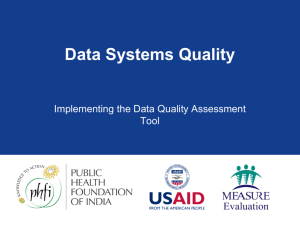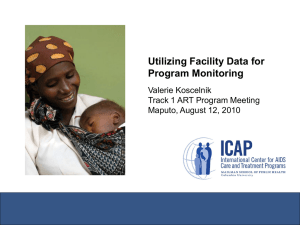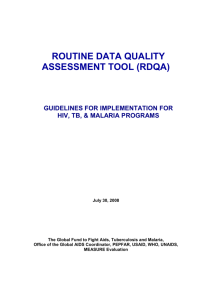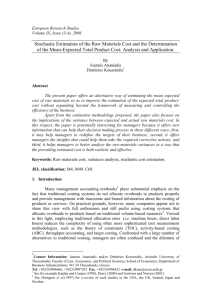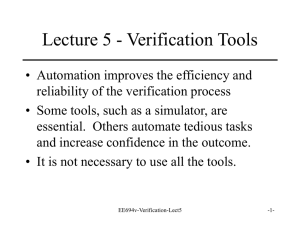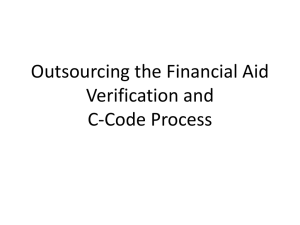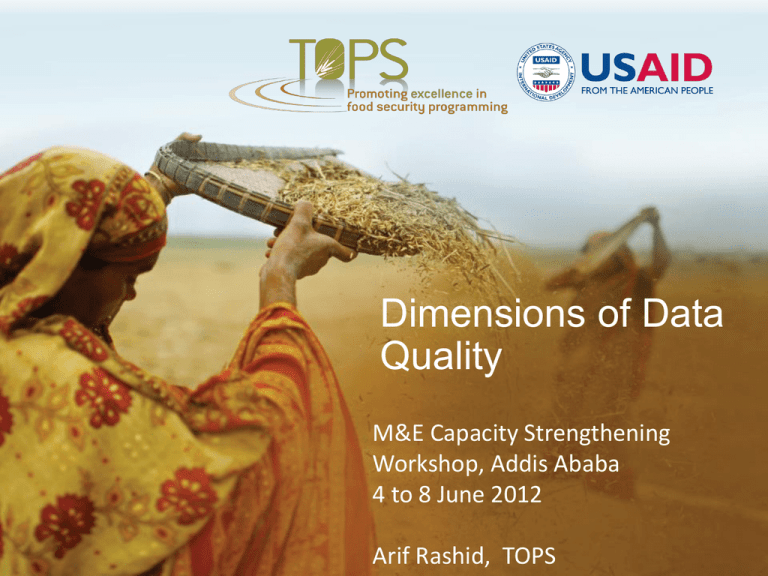
Dimensions of Data
Quality
M&E Capacity Strengthening
Workshop, Addis Ababa
4 to 8 June 2012
Arif Rashid, TOPS
Data Quality
Project Implementation
Data Management System
Project activities are implemented in
the field. These activities are designed
to produce results that are quantifiable.
An information system represents these
activities by collecting the results that were
produced and mapping them to a recording
system.
Data Quality: How well the DMS represents the fact
True picture
of the field
?
Data
Management
System
Slide # 1
Why Data Quality?
•
Program is “evidence-based”
•
Data quality Data use
•
Accountability
Slide # 2
Conceptual Framework of Data Quality
Dimensions of Data Quality
Quality Data
Intermediate aggregation levels
(e.g. districts/ regions, etc.)
Service delivery points
Data management and reporting
system
M&E Unit in the Country Office
Validity, Reliability, Timeliness, Precision,
Integrity
Functional components of Data Management
Systems Needed to Ensure Data Quality
M&E Structures, Roles and Responsibilities
Indicator definitions and reporting
guidelines
Data collection and reporting forms/tools
Data management processes
Data quality mechanisms
M&E capacity and system feedback
Slide # 3
Dimensions of data quality
• Validity
– Valid or accurate data are considered correct. Valid data
minimize error (e.g., recording or interviewer bias,
transcription error, sampling error) to a point of being
negligible.
• Reliability
– Data generated by a project’s information system are
based on protocols and procedures. The data are
objectively verifiable. The data are reliable because they
are measured and collected consistently.
Slide # 4
Dimensions of data quality
• Precision
– The data have sufficient detail information. For example,
an indicator requires the number of individuals who
received training on integrated pest management by sex.
An information system lacks precision if it is not designed
to record the sex of the individual who received training.
• Timeliness
– Data are timely when they are up-to-date (current), and
when the information is available on time.
• Integrity
– Data have integrity when the system used to generate
them are protected from deliberate bias or manipulation
for political or personal reasons.
Slide # 5
Data Quality: Assurance and
Assessment
• Data Quality Assurance - A process for
defining the appropriate dimensions and
criteria of data quality, and procedures to
ensure that data quality criteria are met over
time
• Data Quality Assessment –Review of project
M&E system to ensure that quality of data
captured by the M&E system is acceptable.
Slide # 6
What’s a Data Quality Assessment
(DQA)?
•
•
A data quality assessment is a periodic review
that:
–
Helps Food for Peace and the implementing partner
determine and document “How good are the data?”
–
Provides an opportunity for capacity-building of
implementing partners.
DQAs are required of all USAID data that are
reported to the federal government. It is a
requirement by the US Government.
Slide # 7
Data quality Assessments
Slide # 8
Components of DQA (1/2)
1. Assess four main dimensions of data
collection process:
–
–
–
–
Design
Organizational structure
Implementation practices
Follow-up verification of reported data
Slide # 9
Components of DQA (2/2)
2. Systems assessment of data management
and reporting
– Are systems and practices in place to collect,
aggregate, analyze the appropriate information?
– Are these systems and practices being followed?
3. Verification of reported data for key
indicators
– Spot checks to find non-sampling errors
Slide # 10
M&E Systems Assessment Tools
M&E structures,
functions and
capabilities
1 Are key M&E and data-management staff identified with clearly
assigned responsibilities?
2 Have the majority of key M&E and data management staff
received the required training?
Indicator definitions
and reporting
guidelines
3
Are there operational indicator definitions meeting relevant
standards that are systematically followed by all service points?
4
Has the project clearly documented what is reported to who, and
how and when reporting is required?
Data collection and
reporting forms/tools
5
Are there standard data-collection and reporting forms that are
systematically used?
6
Are data recorded with sufficient precision/detail to measure
relevant indicators?
7
Are source documents kept and made available in accordance
with a written policy?
Slide # 11
M&E Systems Assessment Tools
Data management
processes
M&E capacity and
system feedback
8
Does clear documentation of collection, aggregation and
manipulation steps exist?
9
Are data quality challenges identified and are mechanisms in
place for addressing them?
10
Are there clearly defined and followed procedures to identify
and reconcile discrepancies in reports?
11
Are there clearly defined and followed procedures to periodically
verify source data?
12
Do M&E staff have clear understanding about the roles and how
data collection and analysis fits into the overall program quality?
13
Do M&E staff have clear understanding with the PMP, IPTT and
M&E Plan?
14
Do M&E staff have required skills in data collection, aggregation,
analysis, interpretation and reporting ?
15
Are there clearly defined feedback mechanism to improve data
and system quality?
Slide # 12
Schematic of follow-up verification
Slide # 13
Practical DQA Tips
• Build assessment into normal work processes
• Use software checks and edits of data on
computer systems
• Get feedback from users of the data
• Compare the data with data from other
sources
• Obtain verification by independent parties
Slide # 14
DQA realities!
• The general principle is that performance data
should be as complete, accurate and
consistent as management needs and
resources permit. Consequently, DQAs are
not intended to be overly burdensome or time
intensive
Slide # 15
M&E system design for data quality
• Appropriate design of M&E system is
necessary to comply with both aspects of DQA
– Ensure that all dimensions of data quality are
incorporated into M&E design
– Ensure that all processes and data management
operations are implemented and fully
documented (ensure a comprehensive paper trail
to facilitate follow-up verification)
Slide # 16
This presentation was made
possible by the generous support
of the American people through
the United States Agency for
International Development
(USAID). The contents are the
responsibility of Save the Children
and do not necessarily reflect the
views of USAID or the United
States Government.


